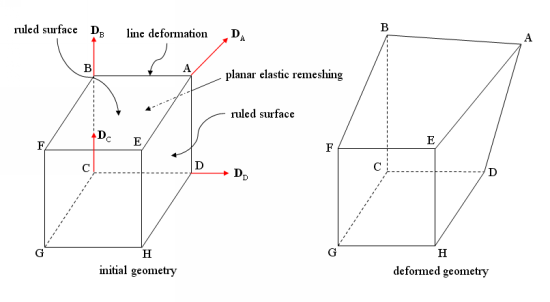When deformation methods are defined for a mesh, it is possible that a node may have more than one equation applied to it. For example, while a node may have a point displacement method applied on it, it may also be associated with a line, surface, and volume, on which different equations are applied. A hierarchy is imposed on the equations to address this situation, such that the equations on the nodes have the greatest importance, then those on the lines, then those on the surfaces, and finally those on the volumes.
In order to illustrate the hierarchy of equations applied on domains of different dimensions, consider Figure 35.10: The Deformation of a Cube by Displacement of Two Nodes. For this example, the intention is to move nodes A and B in the plane of face ABCD.
This example requires the solution of many equations, and several equations are defined at the same locations. Consider node A: this point belongs to one volume, three faces, and three lines, and a mesh deformation method is defined on each of them. Therefore, there are six deformation methods defined at point A:
3D elastic remeshing
planar elastic remeshing on face ABCD (rear)
ruled surface on face ABFE (top)
ruled surface on face AEHD (right)
line deformation on line ABCD
displacement and amplitude imposed at point A.
Or consider the top face: it belongs to the volume, and therefore there are two mesh deformation methods (3D elastic remeshing and ruled surface) applied on the interior nodes of the face.
In order to avoid the summation of the contribution of different equations, a hierarchy is imposed so that the domain of the smaller dimension is solved first. After a value has been computed for a given dimension, its equation is not taken into account when solving for the domain of higher dimension. Hence, the computational order is as follows:
The direction and amplitude for the displacement of points are computed.
The direction and amplitude for the displacement of lines are computed.
The direction and amplitude for the displacement of faces are computed.
The direction and amplitude for the displacement of volume are computed.
The coordinates for points are computed.
The coordinates for lines are computed.
The coordinates for faces are computed.
The coordinates for volumes are computed.



